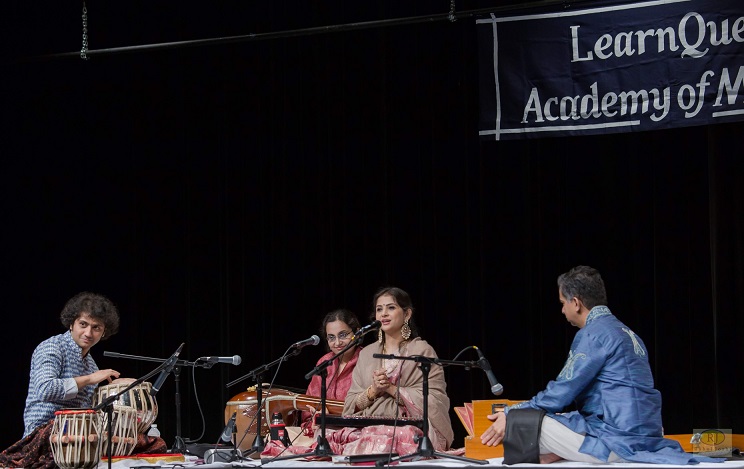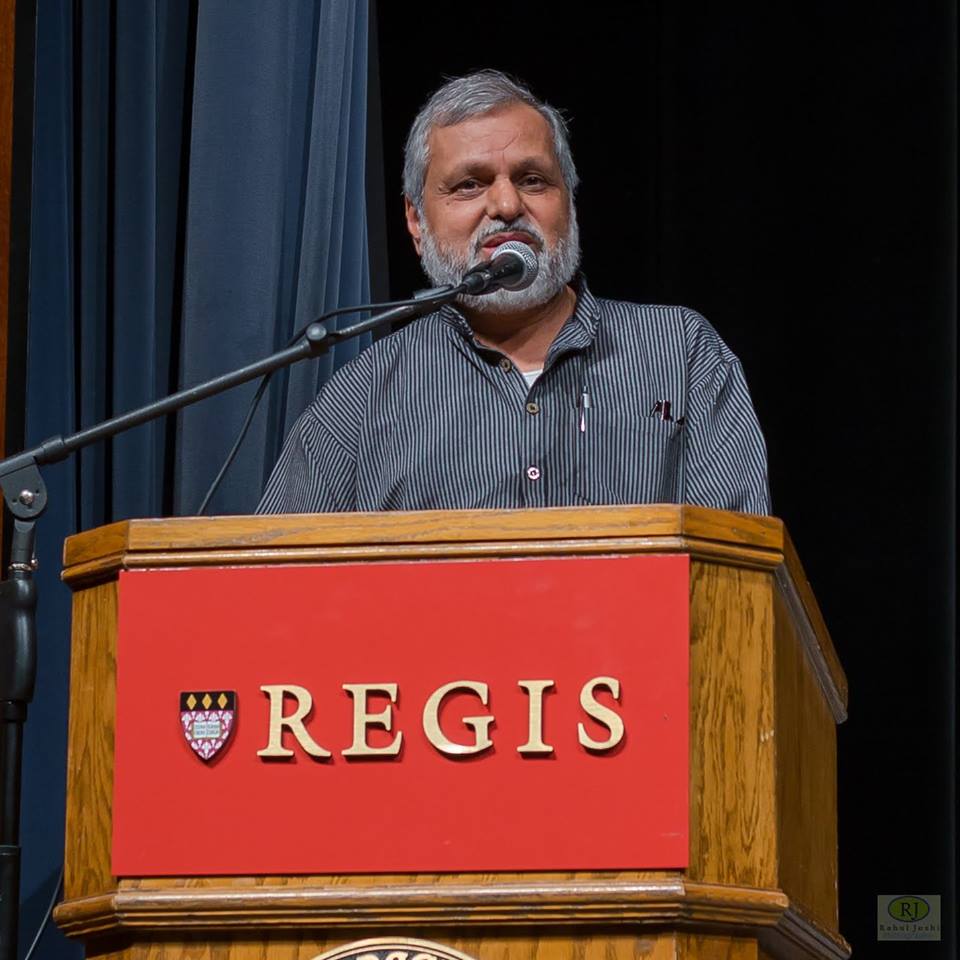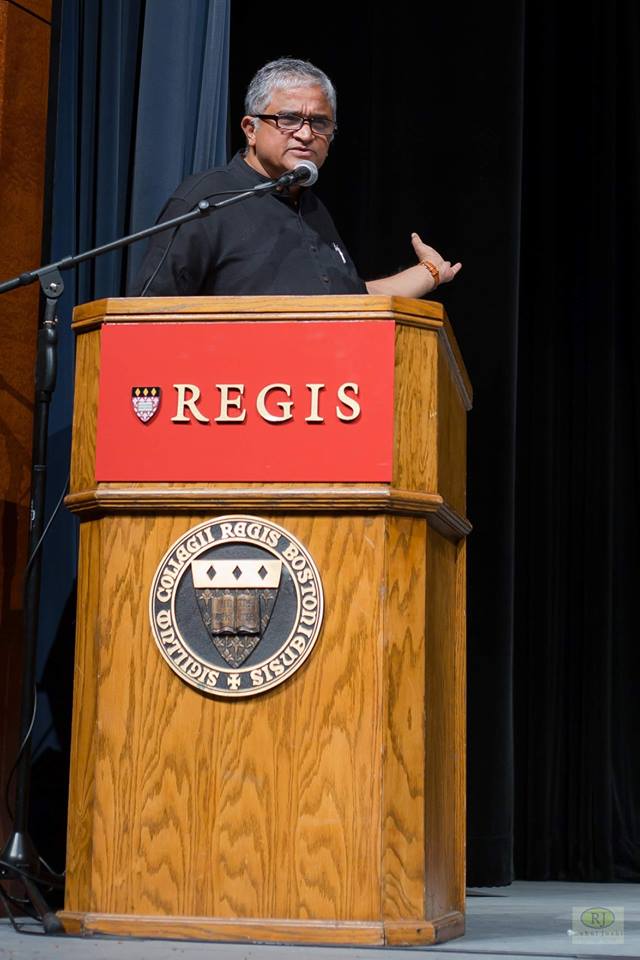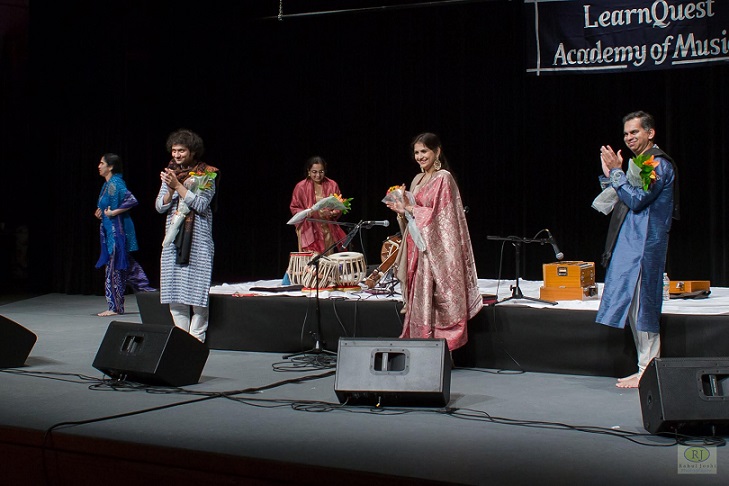Contribute
| Kaushiki Chakraborty Binds Her Audience In A Magical Spell |
Shuchita Rao
09/26/2018
Top-ranking Indian Hindustani vocalist, Kaushiki Chakraborty, a leading representative of the Patiala Gharana gave a wonderful music concert on Friday, September 21 at Regis College, Weston, MA. The three and half hour long concert was organized by the Learnquest Academy of Music. Shri Prashanth Palakurthi, founder and CEO of Boston based software company Reflexis Systems and a long-time supporter of the arts introduced the artists of the evening to an audience of 450 listeners. Citing the main artist’s personal contribution to music, he said “Kaushiki has added femininity, lilt and bhaav to Patiala Gharana gaayaki. To understand what that means, listen to her.†Kaushiki Chakraborty began her concert with a heart-touching apology. Recalling that she had to cancel her scheduled performance at the Learnquest Music Conference held in April 2018 due to an unexpected last minute emergency, she explained the reason for doing so. Her son needed surgery due to an injury as a result of a sudden accident. Referring to her duties as a mother, she said “Behind the person sitting in the spotlight today, there was someone who needed the lights to be turned off. Thank you so much for understanding.†Having established an immediate and intimate connection with listeners in the auditorium, Kaushiki proceeded to delight listeners with three hours of classical and semi-classical music featuring the musical genres Khyal, Thumri and Dadra. Shri Kedar Naphade on the harmonium, Shri Ojas Adhiya on the tabla and Meghodeepa Gangopadhyay on the tanpura provided top-notch support to the artist. Commencing her recital with an hour long rendition of Raag Shyam Kalyan, Kaushiki presented three khyals in the raag, the first being a composition set to slow tempo twelve beat cycle ektaal (adapted from a Dhamar) and the subsequent two compositions rendered in faster tempo and set to ten beat cycle jhaptaal and sixteen beat cycle teentaal respectively. The slow tempo vilambit composition “Diya Jale Bhaktana Aaye Sub Teerath, Atar Sugandh Chaaye Chahu Disa,Sundar Laagey Shyam Moorat†described in two movements, the Sthayi and Antara, the atmosphere of a temple decorated with the bright flame of an oil lamp, the gentle fragrance of incense sticks, the beauty of the presiding deity, Lord Krishna (Shyam) and his devotees(bhaktana). Kaushiki’s tuneful and pliant voice explored the mandra and Madhya saptaks (lower and middle octaves) in an unhurried, langorous manner with nuanced and modulated swar lagaav (application of musical notes) and meend (slide) filled, Dhrupad style ornamented phrases. Engaging listeners with the interplay of the fourth note, an ascending, heightened Teevra Madhyam with a regular Shuddh Madhyam applied in a vakra (zig-zag) descending musical phrase Ga Ma Re Sa. “I am attempting to create the image of a flickering flame through my musical notes†said Kaushiki to the audience mid-way through the rendition. Never losing sight of distinct rest points on Nishad, Shadaj, Rishabh and Pancham notes, Kaushiki rendered several well-constructed sargam and aakaar taans in the faster tempo Shyam Kalyan compositions, “Shyam Chabi Mana Moh Liyo†(Lord Krishna’s image has captured my heart) and “Neend Na aaye piya bin dekhe†(I cannot sleep until I see my beloved). Her uncanny command on sur, taal and layakari showed its powerful presence in rapid, flawlessly executed taans. Kaushiki’s father and Guru Pandit Ajoy Chakarborty as well as his disciples often use the technique of alternating words (bol) and solfege (sargam) within a single taan movement. Adding an element of complexity to the established technique, Kaushiki consistently and deliberately completed her improvisation with unfailing accuracy one beat early, on the 15th beat of the sixteen rhythmic cycle instead of on the routine practice of arriving on the sam, the main beat of emphasis in the rhythmic cycle. It was an exercise that created anticipation and excitement. Next, she sang two pleasing Dadras in Raag Mishra Pahadi. Intricate, vibratory trills adorned the dadra “Ub tho aaja sajna†(It’s time you came, my beloved..) reminding the listeners of the legendary Patiala-Kasur Gharana vocalist, the late Ustad Bade Ghulam Ali Khan Saheb and his imaginative music that used short, intricate taans for embellishing semi-classical renditions. At the request of the audience, Kaushiki sang another popular rhythmic Dadra in the same Pahadi raag “Rang Saari Gulaabi Chunariya Reâ€. Dressed in a pretty pink and silver sari with large, dangling jhumka earrings, Kaushiki seemed to be the very embodiment of the maiden (naayika) mentioned in the Dadra. The fast paced laggi at the end of the dadra was delightful and put the spotlight on the skill of the talented accompanists, Shri Kedar Naphade (disciple of Pandit Tulsidas Borkar) whose unobtrusive and imaginative accompaniment on the harmonium was brilliantly matched by enthusiastic percussive play on the tabla by Shri Ojas Aadhiya(disciple of Mumbai based artist Pandit Mridang Raj). In the twenty minute intermission that followed the first half of the concert, attendees excitedly conversed with each other in the lobby of Regis College Fine Arts Center. “What a charming personality Kaushiki Chakraborty has! By interacting with the listeners she holds the audience under her musical spell†said a concert attendee Swathi Mudnuru. “While I could not fully comprehend what she sang, I was struck by her melodious voice – it was beautiful†said Sekhar Kommaraju. “This was the first full-length Hindustani concert that I attended. I enjoyed it very much and was fascinated by the artist’s vocal range – she touched the top and the bottom of notes of three octaves so effortlessly†said Madhumita Raghu. Commencing the second half of the concert with Raag Rageshri, Kaushiki rendered a moderately paced sixteen beat cycle composition “Sundar Naveli Naar Kar Singaar†(The beautiful maiden dresses up to meet her beloved) and a fast paced khyaal “Raag Sang Raagini Din Mangal Gaaye†(The Raag and Ragini sing that it is an auspicious day). Meghodeepa provided commendable vocal support to her Guru in this rendition. A fusillade of gamak and sapaat taans rained down, drenching the listeners in dizzy delight. Next, at the request of the audience, Kaushiki sang a fast paced composition set to sixteen beat cycle teentaal “Khili Rahi Baran Baran Kaliyaan†in Raag Saraswati. Her training in Carnatic music with the late Dr. M. Balamurali Krishna manifested itself in gamak taans and her rich imagination in developing the raag was very pleasing. On a personal note, I found this rendition to be the best offering of the evening. Ending her concert with the famous Thumri sung by the late Ustad Bade Ghulam Ali Khan “Yaad Piya ki Aaye†in Raag Kaushik Dhwani (also known as Raag Bhinna Shadaj), Kaushiki forayed into several raags outside the raag’s conventional framework to draw out the emotion and sentiment of the lyrics. For instance, to show the pain in the phrase “Ye Dukh Saha Na Jaaye†(I cannot bear this pain any longer) she sang phrases in Raag Lalit using both madhyams in a contiguous sequence to evoke the emotion of sadness. The lightning fast descending movement taan of the thumri rendered with perfect tonal accuracy was very impressive. Smt. Rekha Chitre who has hosted dozens of concerts of famous Hindustani artists under the Kalavati banner said “I have been listening to classical music since I was three years old. In 73 years, I have never heard Bhinna Shadja (aka Kaushik Dhwani) rendered like the way Kaushiki did.†Dr. Pradeep Shukla, founder of Learnquest Academy of Music concluded the program by thanking the team of artists, the sound engineer Jawed Wahid, the sponsors, hosts, media partners and volunteers and also reminded the audience about Kaushiki’s father and Guru Pandit Ajoy Chakraborty’s upcoming performance on November 3, 2018 at Kresge auditorium in MIT. As her parting words to the audience who seemed to want more music, Kaushiki said “Jo hota hai woh Bhagwaan ki marzi aur Guru ke ashirwaad se hota hai†(Whatever happens is because of God’s will and the blessings of teachers).
You may also access this article through our web-site http://www.lokvani.com/





